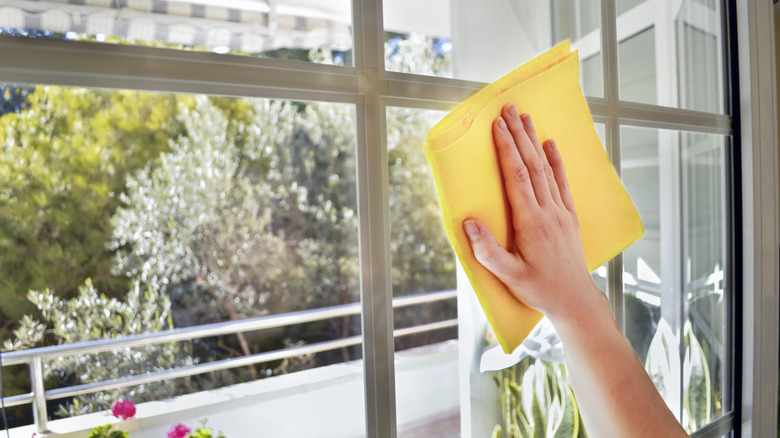Easily Remove Scratches From Glass Surfaces With This Common Household Staple
Glass surfaces add a sleek touch of style to any space, but their elegance can be spoiled by unsightly scratches. However, one common kitchen ingredient can help remove these scratches from glass. Though it's often tucked away behind spices and baking ingredients, baking soda can help restore clarity and shine to your windows, mirrors, and other glass surfaces.
There are so many baking soda cleaning hacks worth trying. The secret of how baking soda helps remove scratches is found in its mild abrasiveness. Baking soda particles are fine enough to gently buff and fill in minor scratches without causing further damage. It acts as a gentle exfoliator, smoothing out the rough edges of the scratch, making it less visible to the naked eye.
To take advantage of this hack, first, you'll need to gather your tools, including a clean bowl or container, a spoon for mixing, a soft microfiber cloth, and baking soda. Opt for plain white baking soda, as gel or scented varieties may contain additional ingredients that could harm the glass.
Make a baking soda paste
With all of your supplies gathered, it's time to clean the glass surface. Thoroughly clean it with warm water and gentle dish soap to remove any dirt, grime, or residue. This gives the baking soda an even cleaning field free of existing debris. Then, make a baking soda paste by combining baking soda with water in the container or bowl. Start with equal parts baking soda and water, and adjust as needed to achieve the desired texture. Aim for a consistency similar to glue.
Less is more, so apply a small amount of the paste to your microfiber cloth, and remember that a little goes a long way. Gently rub the paste onto the scratched area in a circular motion, applying light pressure. Don't scrub aggressively, as this can worsen the scratch. Be patient and work your way through the entire area. After buffing, rinse the paste thoroughly with clean water and dry the surface with a clean, dry cloth. Inspect the area. If the scratch remains visible, you can repeat the process a few times but stop if you notice any further damage.
Precautions and tips for using baking soda on glass
If you have a large area of glass to cover, break it down into smaller sections to make the process more manageable. And, as mentioned, make sure once you're done rubbing the baking soda into the glass that you rinse the glass thoroughly. If you leave any baking soda residue on the glass, it can attract dirt and grime, which leads to the glass giving off an uneven and blurry finish.
It's also worth noting that not all scratches are created equal. Deep gouges or major cracks will likely require professional attention. Baking soda is best suited for minor surface scratches and fine lines that catch the light and slightly distort your view rather than clearly broken panes of glass. Additionally, This is also an easy way to clean glass stove tops. Keep in mind that this method may take some time and should be done at a slow, leisurely pace. Removing scratches takes time and effort. Don't expect the results to be instantaneous, but with patience and gentle polishing, you'll see a noticeable improvement.


